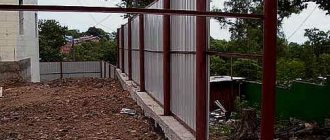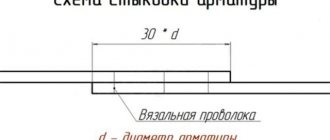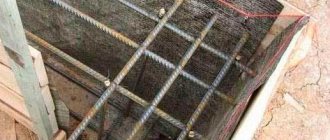What protective layer of concrete should be made for the reinforcement?
Purpose of the protective layer:
- Fastening reinforcement in the thickness of the structure;
- Ensuring joint loading of reinforcement and concrete;
- Effective protection of reinforcement from external influences: atmospheric, chemical or other corrosion, high humidity, frost and other harmful factors.
Corrosion of reinforcement in concrete.
Moreover, if the thickness of the layer is insufficient, the reinforcement material will begin to deteriorate, and if the thickness is higher than the established optimal norm, the cost of construction will increase. At the same time, the thickness of the layer body for various cases is stipulated by the regulatory document SNiP 52-01-2003 and depends on the following main factors:
- Type of fittings;
- Mechanical load and the nature of the mechanical load: longitudinal, transverse, structural, stressed and unstressed;
- Type of reinforced concrete products;
- Sectional capacities of reinforced concrete elements;
- Operating conditions.
Protective layer of concrete for reinforcement corresponding to SNIP 52-01-2003.
- Longitudinal unstressed reinforcement, including reinforcement stressed by stops, must have a protective layer of building material with a thickness of at least the diameter of the rod, wire or rope. Moreover, if the slab wall has a thickness of less than 100 mm, the minimum layer of building material should be 10 mm; For slab wall thicknesses of more than 100 mm and for beams with a cross-section of up to 250 mm, the layer thickness is 15 mm. For beams with a cross section of more than 250 mm - the optimal thickness of the concrete layer is 20 mm, for foundations - at least 10 mm;
- Longitudinal prestressing reinforcement must have a protective concrete body at least 2 or 3 times the diameter of the reinforcement elements, depending on its location and type of loading. In this case, the minimum layer for a rod is 40 mm, for a rope – 20 mm;
- If the prestressed reinforcement is stretched over concrete and is located in channels, the layer of material to the nearest channel is taken to be “at least 0.5 of the hole diameter” or 20 mm or more. For a bundle of metal rods with a diameter of more than 32 mm, the thickness of the layer body is “not less than 32”;
- Longitudinal prestressing reinforcement in various reinforced concrete products must have a protective concrete body: flat and ribbed slabs, walls and wall panels - 20 mm; beams, trusses and columns - 25 mm; foundations and foundation blocks – 30 mm, underground structures – 20 mm;
- Protection of the end part of the reinforcement. Recommended minimum layer: 10 mm for reinforced concrete products up to 9 meters long; 15 mm for reinforced concrete products up to 12 meters long and 20 mm for reinforced concrete products longer than 12 meters;
- For clamps and frame structures reinforced with transverse rods, with a cross-section less than 250 mm - a protective coating of the material of at least 10 mm, for sections larger than 250 mm - 15 mm;
Thickness of the protective layer of reinforcement.
Thickness of protective layers
Specific values for the thickness of the protective layer of concrete are established by regulatory documents - SNIP and Codes of Rules created on their basis. In this case, the features of the reinforced concrete structure, which were mentioned above, must be taken into account.
The standards are “scattered” across several documents, so he will still try to do some kind of “sublimation” to make the picture as clear as possible.
- If we turn to the provisions of SNiP 52-01-2003 “Concrete and reinforced concrete structures”, paragraph 7.3 “Requirements for reinforcement”, then in their subparagraphs about the protective layer it is said that the thickness of the protective layer of concrete should be no less than the diameter of the reinforcing rod, but at the same time and not less than 10 mm.
- Now - Code of Rules SP 50-101-2004 “Design and arrangement of foundations and foundations of buildings and structures.” Here is more specific information:
— For longitudinal working reinforcement of foundation beams (strip foundations) and prefabricated foundations, the thickness of the protective layer must be maintained at least 30 mm.
— For monolithic foundations, it is recommended to prepare the concrete base with a thickness of 100 mm. Compacted sand or crushed stone filling followed by pouring screed is allowed. In both of these cases, the thickness of the protective layer for the longitudinal working reinforcement in the area of the sole must be at least 35 mm.
— If a monolithic foundation, for reasonable reasons, is poured without the above-mentioned concrete preparation, only on a sand-crushed stone bed, then the protective layer in the area of the base should be at least 70 mm.
- The next regulatory document is the Code of Rules SP 52-101-2003 “Concrete and reinforced concrete structures without prestressing reinforcement.” It gives us the following information:
— For reinforced concrete structures located in enclosed spaces with normal or low humidity levels, a protective layer thickness of 20 mm is sufficient for working reinforcement.
- The same, but for rooms with high levels of humidity and without special additional protective measures, the thickness of the protective layer increases to 25 mm.
— For reinforced concrete structures located outdoors, without additional protective measures, a layer of 30 mm will be required.
— For structures located in the ground, including in foundations when performing concrete preparation, a minimum layer thickness of 40 mm is established.
When using prefabricated elements, the thickness of the protective layer for them can be reduced by 5 mm.
For structural reinforcement, the thickness of the protective layer can also be reduced by 5 mm compared to the standards for working rods. But at the same time, a strict rule is still observed so that the thickness of the layer does not become less than the diameter of the reinforcement itself.
- Another very interesting document. If you visit the forums of professional builders, you will notice a lot of positive reviews about the reference manual “Design of Reinforced Concrete Structures” edited by Doctor of Technical Sciences A. B. Golyshev. This book was published back in 1985 by the Kiev publishing house “Budivelnik”, then it was reprinted several times. And, according to many professionals, nothing better has yet been proposed for practical calculations. It makes sense to familiarize yourself with the recommendations of this reference guide:
— The thickness of the protective layer for prefabricated foundations and foundation beams, regardless of the cross-section, is 30 mm.
— For monolithic foundations built on concrete preparation, or without it, but on rocky soil - 35 mm.
— Monolithic foundations without preliminary concrete preparation – 70 mm.
— For transverse, distribution and structural reinforcement, if the minimum cross-sectional size (height or width) of the structure is less than 250 mm, the thickness of the protective layer must be at least 10 mm. For section sizes greater than 250 mm, this parameter increases to 15 mm. It is clear that in this case a single rule applies to them - the thickness cannot be less than the diameter of the reinforcing rod.
The same manual recommends the thickness of the protective layer on the end sides of longitudinal and transverse reinforcing bars, extending along the entire length or width of the reinforced concrete structure.
— For prefabricated elements up to 9 meters in length – 10 mm.
— For monolithic elements up to 6 meters long, with reinforcement diameter up to 40 mm – 15 mm.
— For monolithic elements over 6 meters long with a reinforcing rod diameter of up to 40 mm, as well as for structures of any length with a rod diameter of more than 40 mm – 20 mm.
- Finally, it is also worth looking at SNiP 3.03.01-87 “Load-bearing and enclosing structures”, which stipulates possible deviations from the specified parameters of the thickness of the protective concrete layer:
| Features of reinforced concrete structure | Permissible deviation from the recommended thickness of the protective layer |
| With an established protective layer thickness of up to 15 mm, and linear dimensions of the cross-section of the structure: | |
| — up to 100 mm | +4 mm |
| — from 101 to 200 mm | +5 mm |
| With a set thickness of the protective layer from 16 to 20 mm, and linear dimensions of the cross-section of the structure: | |
| — up to 100 mm | + 4 mm; -3 mm |
| — from 101 to 200 mm | + 8 mm; -3 mm |
| — from 201 to 300 mm | + 10 mm; -3 mm |
| — over 300 mm | + 15 mm; -3 mm |
| When the installed thickness of the protective layer is over 20 mm, and the linear dimensions of the cross-section of the structure: | |
| — up to 100 mm | + 4 mm; -5 mm |
| — from 101 to 200 mm | + 8 mm; -5 mm |
| — from 201 to 300 mm | + 10 mm; -5 mm |
| — over 300 mm | + 15 mm; -5 mm |
Properly using the recommendations of all the guidance documents listed above, you can correctly plan the design of the reinforcing frame for the foundation. There should be no relaxations in this regard (except for those indicated in the last table). Otherwise, the safety and durability of the foundation being created will not be guaranteed.
Absolutely illiterate placement of the reinforcement cage - the lower tier of the reinforcement does not receive any protective layer at all, since it lies at the bottom of the trench
Recommended protective reinforcement layer for various operating conditions.
- When carrying out concrete preparation of foundations - 40 mm;
- When concrete contacts the ground - 75 mm;
- In contact with the ground under the parallel negative influence of weather factors: for reinforcement with a diameter of 15 to 40 mm - a layer of concrete of 52 mm, for reinforcement with a diameter of 10 to 18 mm - a layer of concrete of at least 25 mm;
- When operating structures in conditions of constant high humidity, protection should be at least 25 mm.
For reference. Non-destructive Control of the thickness of the protective “body” of concrete is carried out by special measuring instruments operating on the principle of the magnetic method.
Protection of reinforcement from corrosion in concrete.
Designation and basic properties.
It will not be a secret to anyone that concrete has low strength under tensile forces, therefore, in order to strengthen concrete, they began to use its reinforcement. well withstands tensile forces. This combination allows you to withstand high compressive and tensile loads.
A protective concrete row is a concrete solution poured in a layer that isolates the outer surface of a concrete structure from the surface of the laid reinforcing frame.
It is indispensable for fixing the metal frame in concrete and ensures stable interaction between these two elements under the influence of the external environment.
Reinforcement protective layer clamps.
Violation of concrete pouring technology can have a negative impact on the entire structure in case of minor changes in climatic conditions or humidity levels.
An excessively thin layer of concrete, due to moisture ingress, can lead to corrosion of the metal, and, on the contrary, one that is too thick will lead to an undesirable increase in the cost of the structure.
To determine the optimal layer to protect the reinforcement, the following should be taken into account:
- load on the structure;
- diameter size of metal rods;
- class and type of concrete composition;
- type and cross-section of the structure;
- conditions (high humidity, contact with soil, room without a roof).
Functions of the protective row.
The protective layer of concrete for reinforcement in the foundation is designed to perform the following functions:
Reinforcement protective layer clamps.
- protection of the frame from corrosion (provided by the alkaline environment of concrete);
- increasing the fire resistance of the supporting structure (protects against the influence of high temperatures during a fire);
- protection of the structure from environmental influences;
- ensuring the interaction of the steel frame and concrete;
- anchors reinforcement into concrete;
- base for cladding or protective row that prevents the penetration of moisture.
To find out how to create reinforcement protection and why it is necessary, watch the video:
Ways to Comply with Recommended Standards
The indicator that determines the minimum thickness of the protective layer of concrete for reinforcement is laid down at the design stage. Referring to the requirements of SNIP 52-01-2003, the optimal dimensions of the layer poured between the walls and the edge of the metal rod are determined.
Options for underlays for reinforcement to maintain the protective layer.
At a practical level, all that is required is to conscientiously implement the recommended requirements of the standard regulations. The reinforcement mesh frame located below must be raised above the soil level by a minimum amount, without exposing the metal directly to the bedding. To obtain a concrete layer, it is required to use supports made of various polymers, concrete or stone. It is prohibited to use wood or other moisture-permeable and short-lived materials. The poured solution must be distributed evenly over the formwork; it is forbidden to allow any inhomogeneity in the mass.
In order to maintain the recommended thickness of the protection layer at the time of pouring, the following materials and methods are used:
- Protective layer clamps for reinforcement. These are plastic elements that look like round “stars” or “chairs”. The latter are used to fasten the reinforcement frame and raise it above the base. The “stars” are placed directly on the side rows of the reinforcement cage using a special latch.
- Deliberate lengthening of some metal rods. They rest against the formwork, allowing concrete to penetrate into the free space.
- Concrete fixings. They can be either factory-made or self-made; they are used to maintain a horizontal protective layer.
Let's take a closer look at the most popular technology - the use of factory fasteners.
Plastic clips
To quickly and accurately align and fix the reinforcement frame in the formwork, factory-made plastic clamps are used. Although many product variants have been developed, the main ones are two – “chairs” and “stars”, all other modifications.
Vertical posts in the form of “chairs” measure the protective layer of concrete under the reinforcing mesh, since they lift it above the support. They are produced in different heights, and there are unequal support recesses for the rods. The selection of products is carried out according to the diameter of the rods used, as well as the planned installation height of the frame. They are used for reinforcing monolithic floor slabs, foundations, stairs, lintels, and beams.
Round “stars” are attached to the rods with special type of latches. They are placed on top of horizontal and vertical rods. The radius of the products selected according to the project does not allow the reinforcement cage to approach the formwork wall, thereby guaranteeing the recommended concrete layer to protect the metal.
Plastic fasteners have the following advantages:
- ensure exact compliance with the specified parameters of the metal protection layer;
- reduce work completion time, guaranteeing the quality of the formed structure;
- reduce the costs associated with the production of monolithic reinforced concrete structures.
The main reason why developers use such elements is their low price and ease of use.
Basic norms.
The established optimal thickness of a concrete row is regulated by standards approved by executive authorities:
- Inside houses and buildings with optimal or increased humidity levels - 2 cm or more;
- Inside houses and buildings with high humidity (in the absence of additional protection) - 2.5 cm or more;
- In the open air (in the absence of additional protection) – 3 cm or more;
- In soil (in the absence of additional protection) – 4 cm and more;
- Inside the foundation – 4 cm and above;
- With constant contact with the ground (highest degree) – 7.6 cm or more.
In addition, this document calculates values for fittings and clamps with transverse metal components.
In this case, a layer thickness of 1 cm should be used for a height of the reinforcement circumference less than 25 cm and 0.5 cm above for a greater height of the specified coefficient.
To check the pouring of a protective concrete row, special measuring instruments are used, in which magnetic sensors are installed.
A protective layer of concrete for reinforcement in the foundation.
Main functions
The main tasks performed by the protective layer of concrete for reinforcement include:
- Ensuring the necessary positioning of the reinforcement structure.
- Protection of metal from chemical compounds, moisture and other external influences.
- Uniform distribution of load on the mass of concrete and reinforcement frame.
- Providing a solid foundation for the installation of hydro/thermal protection and/or basement finishing.
- Increased fire resistance of the structure.
It is the protective layer of concrete that is a barrier to any external factors that can damage the structure.
Maximum possible deviations of the protective row.
In accordance with the Building Codes and Regulations, deviations in the thickness of the screening row of concrete are allowed:
- with a layer thickness of less than 1.5 cm - 0.3 cm;
- with a layer thickness of more than 1.5 cm - 0.5 cm;
- with a layer thickness of up to 20 cm - 0.9 cm;
- displacement of the reinforcement rod during installation and in the frame - a quarter of the diameter of the reinforcing rod, but not more than 0.2 of the diameter of the largest rod;
- longitudinal placement of the end or bend of the reinforcement rod - 5 cm.
Depending on the cross-section of the reinforcement and the concrete structure, deviations from the required thickness of the concrete layer, according to the design, can fluctuate within 0.4-0.8 cm in the direction of its increase and 0.3-0.5 cm in the direction of its decrease.
How to determine the optimal concrete thickness
If a heavy fine-grained composition marked B20 and higher is used in the construction process, the cement should reach a value 5 mm less than the cross-sectional width of the rod element. If it is necessary to protect the slabs from corrosion, the layer is also 5 mm smaller than the cross-section. If construction fragments are stretched, bent or compressed, the protective layer of mortar is up to 5 cm.
If professionals lay more mortar, it becomes necessary to install a special mesh from functional components. The technical requirements for the grid in 2021 are as follows:
- The cross-sectional area of the mesh device determines at least 5% of the cross-sectional area of the main reinforcement with which builders work.
- The rods are placed at a distance of 60 cm from each other.
How to properly arrange tension fragments
- If fragments with prestressing are used in construction, cement in places where stress is transferred is allowed in the amount of 2-3 rod diameters of 20 mm or more for bundles and rope products, for rod devices - from 4 cm.
- If it is planned to install structural elements at the supports, the thickness is exactly the same as indicated above.
READ ALSO: How many cubes of concrete fit in a KAMAZ mixer
Repair of the shielding layer.
The correctly selected thickness of a concrete layer cannot guarantee its complete safety; sooner or later it may begin to collapse.
In this case, the restoration of the protective row will help preserve the structure, which consists of sealing all cracks, depressions and chips, as well as completely replacing the entire surface of the formation.
Current repairs include:
- Preparation of the base. This stage of work includes cleaning the area from dust and other deposits where there are defects;
- Surface treatment with a primer;
- Sealing damaged areas. To do this, all chips and shallow sinks are covered, and the cracks are filled with concrete mortar.
Watch the video to get acquainted with the procedure for repairing the protective layer of reinforcement in the foundation:
Complete replacement of the protective layer of concrete for reinforcement in the foundation is necessary when:
- the quality of the material is reduced;
- most of the frame is affected by rust;
- peeling of the shielding layer occurs.
Step-by-step instructions for performing major repairs.
The technology for performing a complete reservoir replacement includes several stages:
- Determining row thickness. For these purposes, it is recommended to use a special measuring device;
- Removing the old layer to the metal frame;
- If necessary, the fittings are cleaned from rust. Depending on the degree of corrosion damage, cleaning methods are chosen: using a brush, grinding, sandblasting. The reinforcement should be processed from all sides. Upon completion of the work, in order to protect against possible corrosion in the future, an anti-corrosion coating based on epoxy or cement is applied to the damaged areas of the metal frame;
- Surface preparation. This stage is performed similarly to surface preparation during routine repairs;
- The final step is the application of several layers of concrete mixture under strong air pressure (a method of shotcrete surface). In this way, the solution particles closely interact with the prepared surface of the structure and fill all voids, cracks and pores. The row thickness should not be less than 3 cm.
If the surface has a large number of defects, is badly damaged, and there is no point in covering it up, in such cases the old layer is not removed, but is built up using a concrete screed.
Recommendation: This is just a review article, from it you will roughly learn what a protective layer of concrete is for reinforcement in the foundation. In reality, if the layer is small, the concrete will peel off and there will be problems, because It will be quite difficult to apply a new protective layer. Therefore, there is no need to be stingy; make a protective layer of 50 mm. and you won't have any problems.
Major repairs of the protective concrete layer
Complete replacement of the formation is carried out in several stages.
- First, determine the thickness of the peeled concrete; you can use a special device.
- Then the previous layer is completely removed, leaving only the metal frame.
- If necessary, the fittings are cleaned of rusty stains; for this you can use various tools, a brush, or a sandblasting machine. After this, the metal elements are treated with an anti-corrosion agent.
- Then the surface is prepared and concrete is applied in several layers under significant air pressure. At the same time, all voids and cracks are filled, the thickness of the row is made from 3 centimeters.
When constructing a concrete structure using reinforcement, the thickness of the protective layer must comply with the standards. If the surface is partially destroyed, then minor repairs are made by filling the defects with a solution. If it is completely destroyed, the previous solution is cleaned to the base, and the filling is done again.











